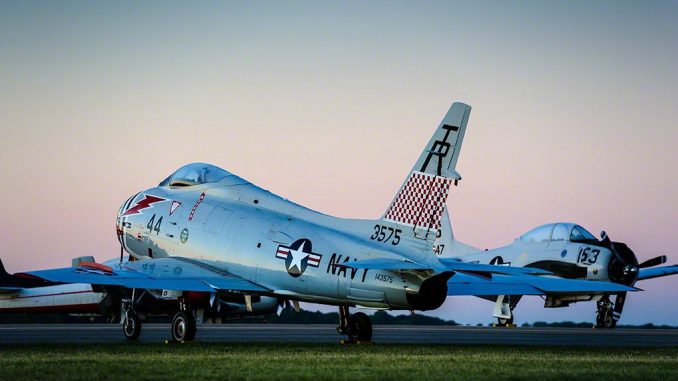
Jake Peterson Reports:
Every year a gathering of people and aircraft come together in one big celebration of freedom, technology, and patriotism. That event is EAA Airventure in Oshkosh, Wisconsin. For one week people of all ages and nationalities come out to watch the performances of some of aviation’s best. During that week hundreds if not thousands of aircraft line runways 2 7 and 3 6. Everything from homebuilt to antiques, to warbirds, and modern jets are there supporting the event. With this great diversity comes some truly rare planes, one of which saw this year was the North American FJ-4B Fury, BuNo 143575.
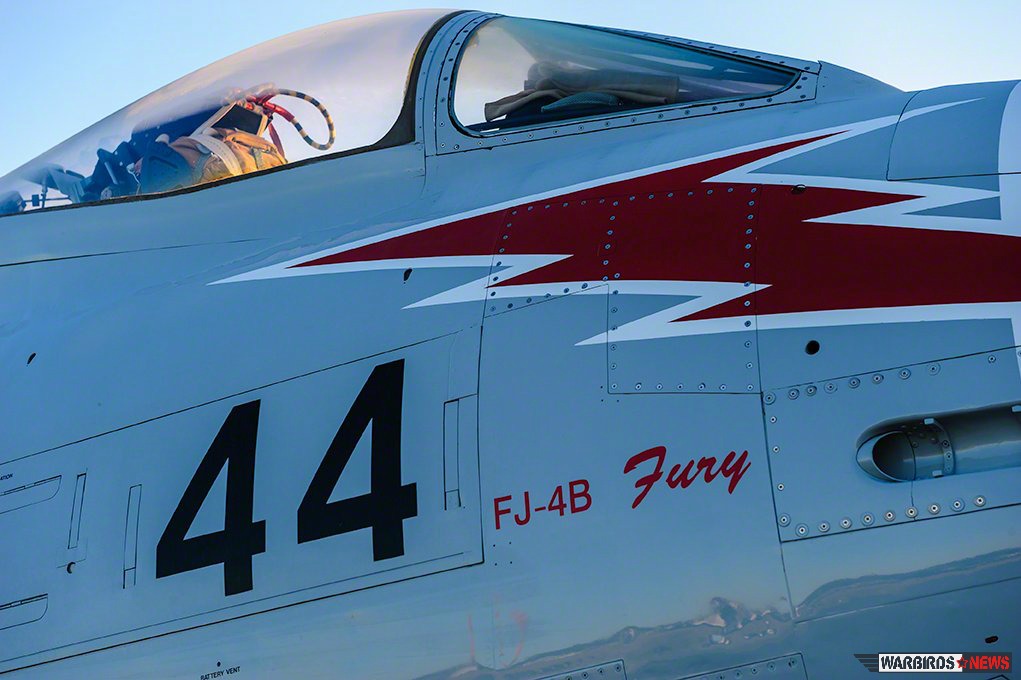
The FJ-4B is a variant of the FJ-4. The -4B was designed as an attack aircraft and not just any attack aircraft, but the first one designed to carry a nuclear bomb off of a carrier deck. The FJ-4B weighed in at 13,500 lbs. empty and had a takeoff gross weight of 28,000 lbs. It could travel 1,640 nautical miles on internal fuel but could extend its range to 2,500 miles with four external 200-gallon drop tanks. The FJ-4B was extensively utilized, including being deployed with nine US Navy and three Marine units, later replaced in the 1960s by the Douglas A-4 Skyhawk.
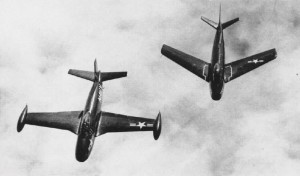
(Image Credit: US Navy)
The FJ-4B has had a long and unique history, as it came a long way from its initial planning. The US Navy’s FJ series started its development in the 1940s around the same time that the USAF F-86 Sabre jet was being developed. The first model, the FJ-1 Fury was a subsonic fighter with straight wings and used the 3,820lb thrust GE-Allison J35 engine; however, after the Germans proved the efficiency of the swept wing design during World War II, later models, including the F-86 Sabre Jet, adopted similar swept wing designs. The FJ-2 Fury incorporated the GE J-47 engine with 6,000lbs of thrust, folding wings to help conserve space on aircraft carriers, and 4 20mm cannons instead of the six 50-caliber machine guns the F-86 had. However the FJ-2 was 1,000lbs heavier than the F-86A and due its lack of performance, the FJ-3 Fury was developed with the Wright J-65 engine, providing 7,600lbs of thrust. The FJ-4 was designed as a long-range fighter and was equipped with a larger fuselage, and longer, thinner laminar flow wings allowing for more fuel to be carried.
Due to the plane’s greater roll authority, good low-speed handling characteristics, and supersonic capabilities, the FJ-4B was a well-balanced carrier attack plane. The FJ-4 was equipped with wide-tracked landing gear, a catapult hook, and an A-frame arresting hook. The FJ-4B model was also equipped with the Wright J65-W-16A axial flow turbojet engine with a thrust capability of 7,700lbs. One of the unique characteristics of the -4B is that it was equipped with a “buddy system.” 2 FJ-4B’s would take off from the carrier and meet up at a pre-arranged position. One would have the “special store” and the other the buddy system. After refueling the attack plane would carry on with its mission while the other returns to the carrier. The FJ-4B was also the first aircraft equipped with the Low Altitude Bombing System (LABS). The LABS system was an automatic system that provided the correct technical information for a low-angle attack run and release of a nuclear bomb, as well as the correct pull-out procedure to avoid the nuclear blast.
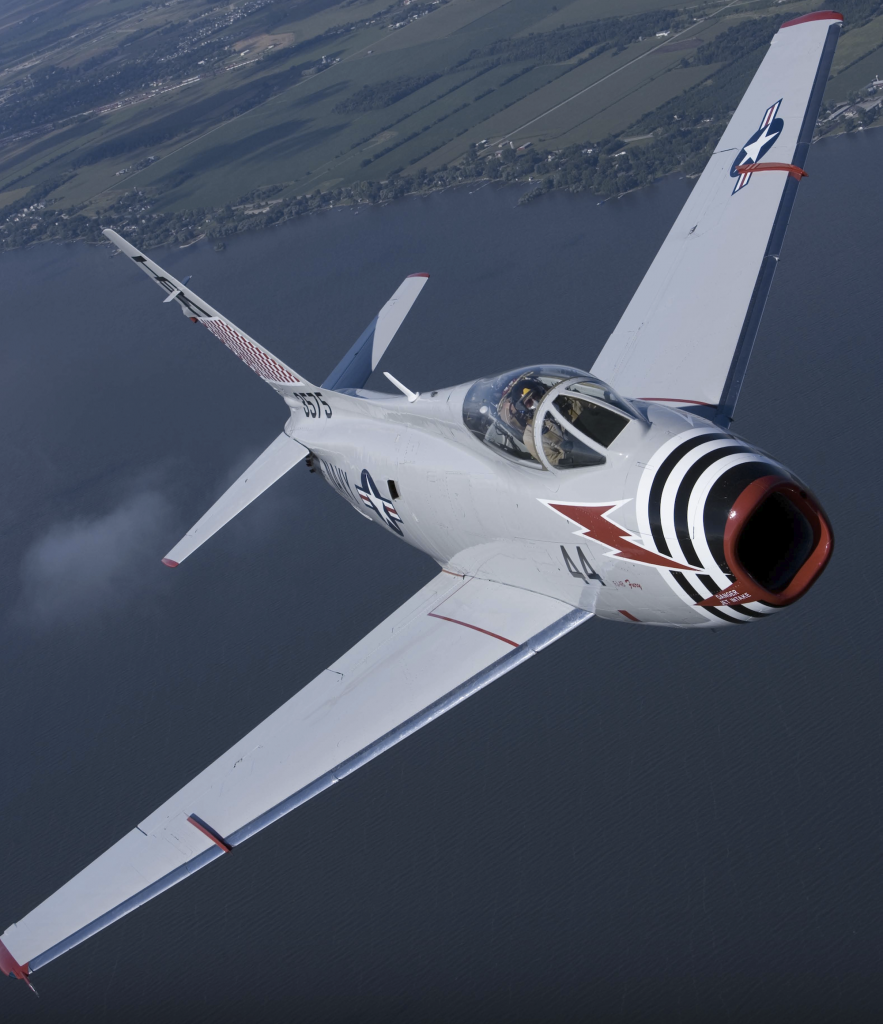
(Image Credit: MiG Fury Fighters)
Of the 374 FJ-4s built only one remains flying! It was built in 1958 in the second to last batch of 222 aircraft. It was delivered to VA-192 “Golden Dragons” on board the USS Bon Homme Richards, served with several other Navy squadrons, and ended its Navy career on board the USS Hancock part of VA-216, the “Black Diamonds,” during Vietnam. After Vietnam, it was sent for demolition at Litchfield Park, Arizona but was missed and was bought by former NAA test pilot and President of Flight Systems in Mojave, California, Bob Laidlaw, in 1971. Laidlaw was looking for an aircraft that could stay subsonic in a near-vertical dive from above 50,000ft. to fulfill a civilian contract to test the pattern-matching system of a Pershing II intermediate-range ballistic missile. With the four large speed brakes on the FJ-4B, part of the LABS system, the FJ-4B fit the profile. BuNo143575 was restored to flight status and flew over 700 hours of testing with a Pershing II slung under its wing. It was registered during this time as N400FS, the registration it still bears today.
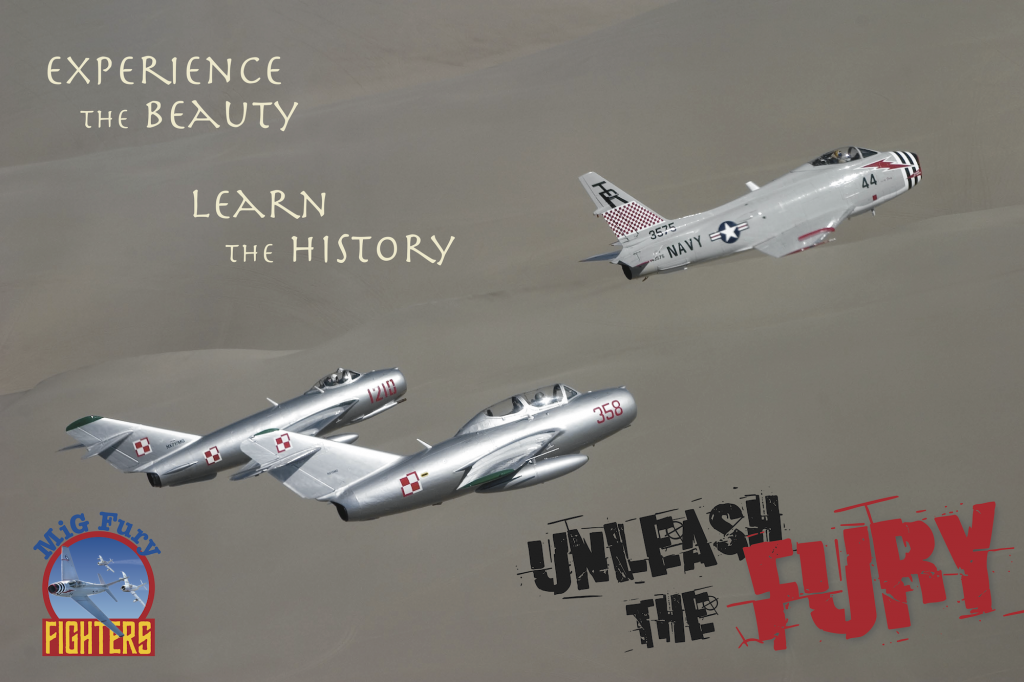
(Image Credit: MiG Fury Fighters)
After the tests were completed, BuNo143575 was left derelict in Mojave until it was bought in 1991 by Larry Mockford of T-bird Aviation who began to restore her. It was later bought from Larry by MiG Fury Fighters in Driggs, Idaho where it currently resides. N400FS finished in the markings and paint scheme of the Fleet Air Gunnery Unit of NAS El Centro, and goes to air shows to promote Naval Aviation, with the Fury performing in aerial dogfights with the other warbirds in MiG Fury’s fleet, a MiG 15bis and a MiG 17F.



My dad flew the FJ-3 in June 1955 through July of 1957 when he started flying the F8U-1
C.O. Thompson VF-154
Hy see you again!
I wish to receive plans of knox class frigate hulls .
Can you help me? Thankyou.
I was plane captain of a FJ4B in VA144 from 1958 to 1960. Made 2 cruises on the Ranger CVA61 with that plane. We were buddies.
i made the last fj4b cruise with va216 in 1962 aboard uss hancock, cva 19. I flew buno 143575 on several occasions. I was part of a flight of four that made the last carrier landings for the fj4b. that was on august 13, 1962. Ltjg david ingham who was part of the flight , made the last carrier landing for the fj. the end of an era.
Thanks for sharing your memories with us Edward!
I made the first Martin-Baker ejection from the FJ-4B September 10th, 1961, on a dark night off the USS Hornet, CV-12. We were getting night qualified and I was the first to be launched after turning down the first two birds(old North American seats) due to mechanicals. I spread the wings hydraulically and may not have gotten the locking handle fully stored. As a result, after the launch, the aircraft began a slow roll to the right. It was discovered later that with the locking handle not properly stored, the ailerons are locked. So, passing 30 degrees of bank at about 100 feet, 160 knots I decided to eject, which was thankfully, successful.
I joined VA-216, the last FJ-4B squadron right after and was later transferred to VA-144, flying the A4C, as the Navy was running out of the 4B, with my help. Thanks to Ed Haas, and his clerical capabilities, I received some phony transfer orders which spiced up my six month stay with the Black Diamonds.
The FJ-4B was the best airplane I ever flew. I had never seen a 4B without racks and tanks until I flew one from Alameda to Miramar one cold winter day. 3500 pounds of fuel and a clean wing got me to 55,000 feet (not too smart) and supersonic. The practice flame-out approach into Miramar served me well.
Regards, Jim Walker
I worked on them during my service in the USNR-R TAR at NASNY in the late 50s, early 60s until we transitioned to the A4D-2. I let in August 1965 as an AE1. I was also a plane captain & run & taxi qualified. Also helped change a few engines on the 4B & the 3 earlier.
on the FJ4&4B there was a starter generator on the nose of the engine. what are they using to start the aircraft, have not seen any NC5 for electrical power on his starts. I was in VA126 and worked as plane capt. and engine shop on the fj4b and the A4D, both used the J65 engine. was with the va126 from april 1959 to april 1961
Flew this very a/c in VF/VA-791 at NAS Memphis. One of my favorites!
I worked on this same aircraft at Flight Systems in Mojave, 1981-1982
I flew the FJ-3, FJ-4 and FJ-4B during two and a half years in Utility Squadron 7 at Brown Field (Southeast of Chula Vista, Ca) they were all wonderful to fly after having been flying the earlier Panthers. There was significant difference between the three models. The 4 and 4B were fairly close in some ways but the B model included a variety of internal and external changes that that did make it over all the ultimate Fury class best. A side story: I was towing a banner for air to air gunnery training of a flight of 4 Crusaders. One of the pilots was flying sucked runs and I had warned him a couple times before I heard a thock. I figured I had been hit so I closed the range and had the flight leader come down a check me out. He said no observed problems so I opened the range again. On landing the plane captain came out to put the chocks around the tires. He stopped in mid step and, with open mouth, was looking at the fuselage of the plane. I was pretty sure what he was seeing. There was a long bullet entry into the plane. The bullet hit the last stage of the engine and shattered, throwing pieces around the enclosed part of the plane. Included was pieces that went into the wing fuel tanks. Nothing hit a critical part so the plane flew normally. That plane, because they were being phased out, never flew again. The Crusader pilot bought me a bottle of Black label Jack Daniels whiskey and his crew painted an FJ-4 on his plane. I loved my time as a pilot but returned to civilian life, which has also been great. Still going strong at 87. (written in December, 2022)